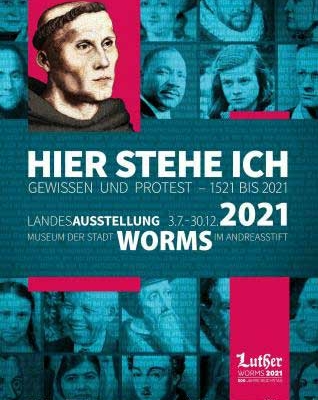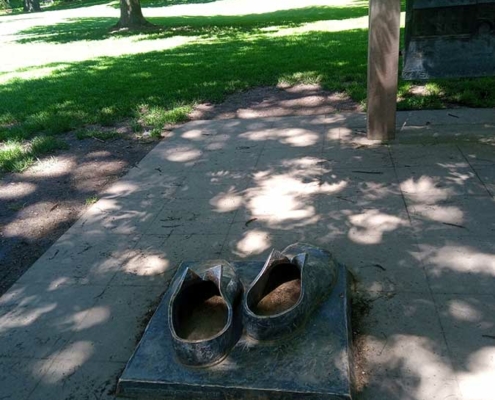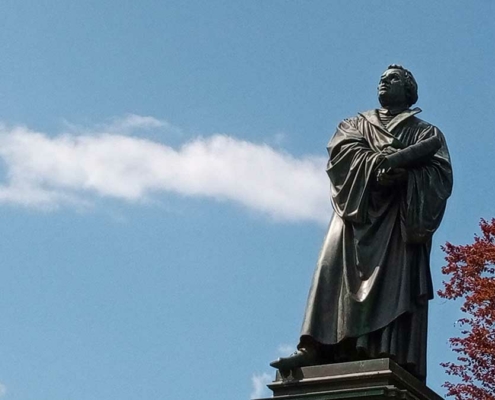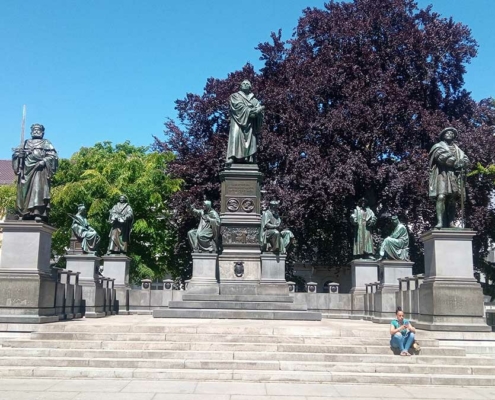The Luther dossier in Worms
Two days in Worms that changed the world
A compact summary of the Martin Luther thriller
Worms has an eventful historical past. As early as 5,000 BC, the climatically favoured area was settled by the Celts. Around 35 BC, the Romans finally found their way here and brought more than just wine to Rheinhessen. With the Romans, Worms became more than just a settlement area. It first became a “province” and increasingly gained in importance. Quite a few events that happened here still have an impact on the Christianised world today. Who is not familiar with the expression “going to Canossa”? That penitential walk in which the emperor had to ask the pope for forgiveness, simply put. This walk was ultimately a consequence of the Imperial Synod in 1076, to which Emperor Henry IV invited in Worms with the aim of breaking away from the Roman Catholic Church in Rome.
Probably even more famous is the saying “Here I stand and can do no other! The phrase is attributed to the pugnacious theologian Martin Luther, who was summoned to Worms in 1521 to recant his 95 Theses published in 1517. As is well known, he did not do so and is said to have uttered those famous words in the process. As texts now suggest, Luther’s saying was a little different, but not so far removed from the famous quote:
„(…) Und so lange mein Gewissen durch die Worte Gottes gefangen ist, kann und will ich nichts widerrufen, weil es unsicher ist und die Seligkeit bedroht, etwas gegen das Gewissen zu tun. Gott helfe mir. Amen“
The consequences of this sentence shook Europe, led to the division of the church and the Thirty Years’ War. So you could say that the idea of the Reformation spread from Worms to the world. But how did it come about in the first place and why was Worms chosen as the place where the Imperial Diet was held?
Martin Luther, born in 1486, studied theology in Wittenberg and was a convinced representative of humanism. In 1510 he travelled to Rome on behalf of his order. There he was appalled by the pomp with which the Roman Catholic Church demonstrated its power. The God-fearing man began to wonder whether this was in the spirit of Christian teaching, which preached humility and modesty. Back in Germany, which was still the “Holy Roman Empire” at the time, he increasingly began to denounce the abuses.
In particular, the practice of selling indulgences, God’s forgiveness in exchange for money, and simony, the practice of buying and selling influential church offices, came into focus in his texts and formed the basis for the 95 Theses, which Martin Luther effectively nailed to a door in Wittenberg on 31 October 1517. In addition, these 95 Theses, originally written in Latin, were sent to the Archbishop of Mainz. A translation into German followed. The invention of printing (in Mainz) finally ensured that Luther’s theses spread throughout the empire at breakneck speed and he became something like the first media star.
In 1520, Charles V, just 20 years old, was elected Holy Roman Emperor. Under the influence of Pope Leo X, the young emperor declared Luther a heretic on 3 January 1521 and imposed on him a bull of excommunication and the imperial ban (without rights and outlawed). For Luther, who firmly believed in purgatory, this was a human catastrophe. Nevertheless, he refused to back down from his powerful criticism.
On 27 January 1521, the Emperor opened the Imperial Diet in the “free city” of Worms. Originally, it was to take place in Nuremberg. Since the imperial city of Nuremberg was ravaged by several epidemics at the time, the choice fell on the historically rich city on the Rhine (there had already been an Imperial Diet in Worms in 1495). Charles V finally travelled to the city, which at the time had 7,000 inhabitants, on 28 November to prepare for the important and, above all, nationally popular Imperial Diet. In short, the Imperial Diet was the outstanding event of its time.
The main topic was to be the reorganisation of the balance of power between the crown, princes and cities. Along with the 80 or so princes, some 3000 other envoys and followers travelled to the city. Some sources even report that about 10,000 additional visitors arrived. This led to an increase in the cost of food, housing became scarce and disputes broke out everywhere.
The powerful negotiated for four months when, surprisingly, Martin Luther was put on the agenda. Actually, the Pope and the Emperor thought that the ban was the end of the story. But they were wrong! For the Pope’s envoy in Worms stated that “nothing else was being sold except Luther’s writings”. So there was no getting around the subject any more.
So Charles V summoned Luther to the Imperial Diet with the aim of having him recant his 95 Theses before the secular and ecclesiastical powers of the land. On 2 April 1521, Martin Luther set off from Wittenberg to Worms. When he arrived in Worms on 16 April, trumpet fanfares greeted him while the people cheered him.
On 17 April, the emperor and Luther met for the first time at a preliminary hearing. At first Luther believed he could convince the Emperor, but after only a few hours he was proved wrong. Charles V let Luther know that he expected a retraction the following day. On 18 April, the popular theologian and the powerful emperor finally came to a big showdown. The encounter finally ended with the above-mentioned quotation. Further rounds of talks followed over the next few days, with scholars in attendance, which were supposed to persuade him to recant after all. As it turned out, in vain.
On 26 April, Luther and his companions finally started their return journey. On the way back, there was a staged attack and the abduction of Luther. This was initiated by Elector Frederick the Wise, who was well-disposed towards Luther. He had the “outlaw” brought to Wartburg Castle. The Diet in Worms ended again on 26 May with the Worms Editkt, i.e. the imperial ban imposed on Martin Luther. In 1524, the first Protestant mass on German soil was held here in Worms. Likewise, the first English-language version of the New Testament was written here in 1526. To this day, despite the architectural dominance of the Catholic churches, the city has a Protestant influence, which is reflected above all in the population structure.
In the footsteps of Martin Luther in Worms
The former imperial city of Worms was twice the victim of great destruction. Once as a result of the Palatinate War of Succession in 1689 and finally shortly before the end of the Second World War, by two air raids. As a result of these destructions, many historical buildings were irrevocably destroyed, including the then Bishop’s Court in the immediate vicinity of the cathedral, where Luther had to appear before the Emperor. Nevertheless, it is still possible to follow Luther’s footsteps in Worms today.
This can be done most impressively at the Luther Monument, the world’s largest monument to the Reformation, designed by the Dresden artist Ernst Rietschel. It took twelve years to complete. It was finally unveiled in the presence of Prussian King Wilhelm I and numerous spectators on a blazing hot summer day on 25 June 1868. Historical sources say that 3,000 guests of honour alone had travelled to the site at that time. There were 15,000 grandstand seats and allegedly 100,000 visitors. The monument celebrates not only Martin Luther, who, with a fist on the Bible, so to speak, symbolically represents his theses with a proud and clear gaze, but also other important figures in the history of the Reformation. Explanations of the people depicted can be found on the homepage:
www.worms-erleben.de/erleben/entdecken-und-staunen/sehenswuerdigkeiten/lutherdenkmal.php
The technically interesting app “Experience Worms (AR)” also offers comprehensive information. The monument is enclosed in a crenellated wall that symbolises the well-known Luther hymn “Ein feste Burg ist unser Gott” (“Our God is a Mighty Fortress”) in a way that you can touch. At the same time, other people, places and scenes of the Reformation are illustrated in the tour. The monument is surrounded by an impressive green area, Lutherplatz, which is attractively landscaped by the city’s Parks Department depending on the season.
Immerse yourself in the Diet of Worms with a virtual reality app
The app “Experience Worms (AR)” just mentioned does not offer detailed information about the monument, but sends the user on a Luther tour. By using a so-called “Argumented Reality (AR) technology”, past and present merge into an entertaining experience. The technology gives the viewer a virtual insight into the time of the Imperial Diet in 1521. The tour begins at the Luther Monument and leads to six historically significant locations marked by stelae. By means of a QR code, which can be scanned on the steles, the visitor is immersed in the past. Buildings appear before your eyes, while people also appear directly in front of you. The journey, during which you also meet Martin Luther, is guided informatively by the imperial herald Kaspar Sturm. Based on the look of a graphic novel, the app offers an entertaining way to experience history. However, those who want to do without virtual reality can also have it told to them. It makes sense to use headphones when using the app. Since the app consumes quite a bit of power during the 90-minute tour, it makes sense to make sure the battery is well charged beforehand. The app is free and can be found in both the AppStore and the Google Play Store. However, it is important to enter the exact term “experience Worms”, otherwise you will come across numerous apps that refer to the game “Worms”.
Here I stand and can’t help myself: Luther’s shoes in Heylshofpark Worms
If you want to follow in Luther’s footsteps, you should of course visit the Heylshofpark in Worms, not far from the Luther Monument. Anyone using the app will be guided to the green oasis in the middle of the city anyway. The Bishop’s Court was located there 500 years ago. A bronze sculpture in the shape of oversized shoes symbolises the place where Luther is said to have stood before the emperor. Incidentally, anyone who suddenly hears voices in the park should not worry about possibly having acoustic hallucinations after their tour of the city. 24 loudspeakers with small, but easily recognisable, light and quietly pulsating light sources are distributed throughout the park. Motion detectors register when someone comes close to the specific spot and activate a loudspeaker with questions of conscience. 24 questions are asked, one question per location. “Questions to the “today”, arising from a moment 500 years ago with answers from us now”, it says on the homepage wormserleben. The city itself calls this a “thinking space”. However, one can simply also be inspired by the lush green of the meadows, the gnarled ancient trees and the mighty cathedral that seems to watch over the park with its massive towers. Or, to put it another way, it’s a place ideally suited to unwinding.
Luther exhibition in the Andreasstift
If you want to follow in Luther’s footsteps, you should of course visit the Heylshofpark in Worms, not far from the Luther Monument. Anyone using the app will be guided to the green oasis in the middle of the city anyway. The Bishop’s Court was located there 500 years ago. A bronze sculpture in the shape of oversized shoes symbolises the place where Luther is said to have stood before the emperor. Incidentally, anyone who suddenly hears voices in the park should not worry about possibly having acoustic hallucinations after their tour of the city. 24 loudspeakers with small, but easily recognisable, light and quietly pulsating light sources are distributed throughout the park. Motion detectors register when someone comes close to the specific spot and activate a loudspeaker with questions of conscience. 24 questions are asked, one question per location. “Questions to the “today”, arising from a moment 500 years ago with answers from us now”, it says on the homepage wormserleben. The city itself calls this a “thinking space”. However, one can simply also be inspired by the lush green of the meadows, the gnarled ancient trees and the mighty cathedral that seems to watch over the park with its massive towers. Or, to put it another way, it’s a place ideally suited to unwinding.
In the premises of the 1000-year-old St. Andrew’s Abbey and church, the national exhibition “Here I Stand. Conscience and Protest – 1521 to 2021” will take place. The focus is on a historical examination of the theme of “taking a stand”. Arranged in 14 thematic islands, the exhibition presents an attractively designed journey through 500 years of protest history, roughly divided into two parts. Particularly in Protestant milieus, “Worms 1521” is regarded as the birthplace of modern, Western freedom of conscience and is appropriated accordingly in terms of historical politics, which is why the first part explicitly refers to the historical events. In a second part, the exhibition focuses on the topic of “freedom of conscience”, both with and without reference to Luther’s work. The national exhibition deals with important personalities who, from the 16th century to the present day, stood up for their ideals in word and deed and not infrequently paid for their civil courage with their lives. Examples of this are the pugnacious writer Olympe de Gouges and the young Sophie Scholl. Using exhibits, documents, film clips and music, the exhibition makes history tangible. Among the exhibits, for example, is a Bible with a recess in it in which you can hide a pistol. This Bible was given to Winnie Mandela in the 1960s as a warning to her husband Nelson Mandela. The latter was to end his protest to eliminate apartheid. In addition to such moments when people had to stand their ground against hatred and violence, the exhibition also deals with the peaceful protests in the GDR that eventually led to the fall of the Wall.
An eye-catcher, of course, is the museum itself, where the exhibition, which is well worth seeing, takes place. The St. Andrew’s Abbey was first mentioned in 1016. As early as the 13th century, however, the original building was extensively rebuilt. It was used as a monastery for a long time. In the course of the Palatinate War of Succession, the building was burnt down. What remained were the masonry and part of the cloister. Reconstruction lasted until 1761, but even after that, little good happened to the building. In 1792 Worms came under French occupation. The new masters used the monastery as barracks. After the building returned to municipal ownership, the church in particular, which is now the entrance to the exhibition, was used as a car park. When the Worms Antiquities Society was looking for a new home for its historical collection at the end of the 1920s, the city offered the rooms of the Andreasstift as a museum. The collection has been housed there ever since. During the Luther exhibition, however, the upper floors, which house a major part of the collection, are closed. Thanks to the generous donation of a Worms patroness, the former cloister has been lavishly reconstructed and rebuilt over the past two years. This frames the inner courtyard, where readings and small concerts take place during the exhibition period. As exhibition curator Dr Olaf Mückain reveals, the courtyard can also be used as an extra-parliamentary protest space during the exhibition. Posters and demonstrations are expressly welcome.
To visit the exhibition, an online reservation is necessary in advance. Due to Corona, 30 guests are currently allowed to visit the exhibition every 20 minutes. Group tours will not take place due to the current situation.
Further information can be found at:
Summer is festival time in Worms:
The Nibelungen Festival presents “Luther
The Nibelungen Festival has long been one of Germany’s most important theatre events. Against the impressive backdrop of Worms, the open-air festival is usually dedicated to the titular Nibelungen. On the occasion of the anniversary year, the makers are leaving their comfort zone and putting Luther at the centre of this year’s production from 16 July to 3 August, based on original text by Swiss author Lukas Bärfuss. The artistic director of the festival, Germany’s most successful film producer Nico Hofmann (“Der Junge muss an die frische Luft”), explains about the performance that the play is about inner attitude and courage. What exactly the audience can expect in terms of content has not yet been revealed. What is known, however, is the cast. This includes the popular actor Jürgen Tarrach (“James Bond 007 – Quantum of Solace”, “Wambo”) and the actress Sunnyi Melles, who is a welcome guest in numerous series and most recently starred in the lavish cinema production “Narziss und Goldmund”. The Heylshofpark is also an integral part of the Festival and is often rightly described as Germany’s most beautiful theatre foyer. It is unclear at the moment in which setting it will be used this year due to Corona. In normal years, the audience can expect an extensive gastronomic offer in the romantic park, which of course includes a wide range of tasty regional wines. For a small fee (2 euros), the park can also be visited by strollers without a festival ticket. Whether this will be the case this year is questionable. It is also questionable at the moment how many visitors the festival will be able to welcome. At the moment, they are planning on 530. Normally, the grandstand offers space for 1,400 guests. Since the seats are coveted, one should react quickly if interested.
Further information can be found at:
Alle Texte: Dennis Dirigo







